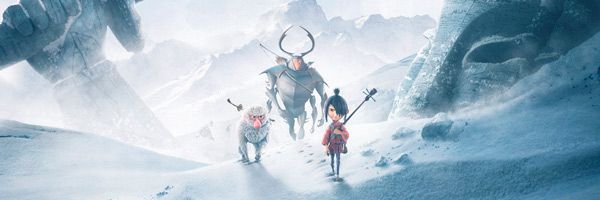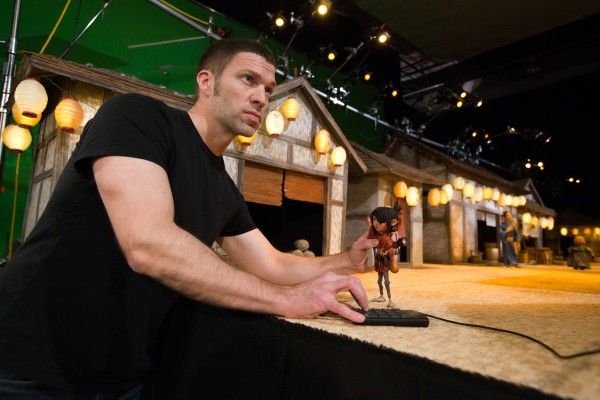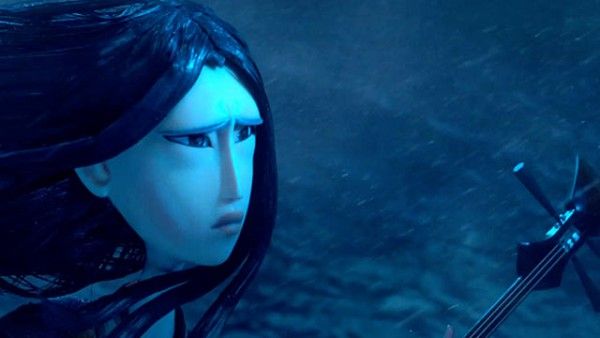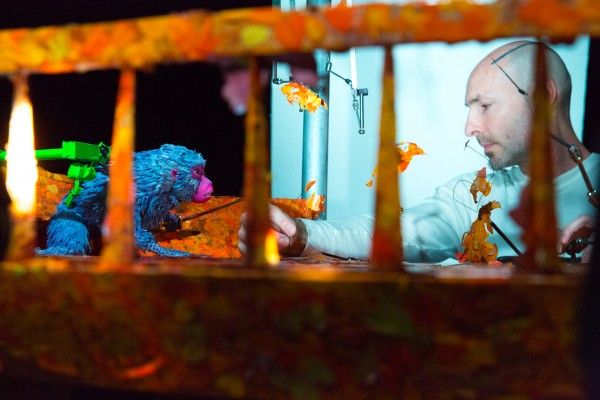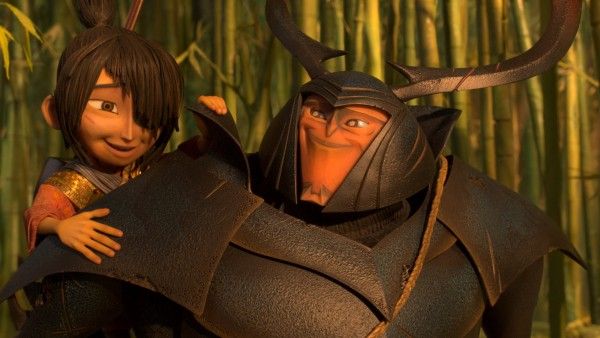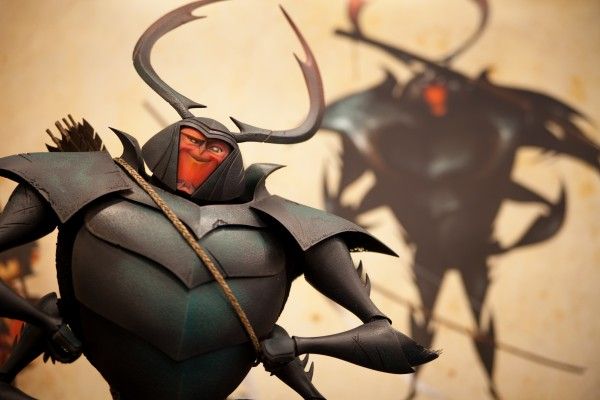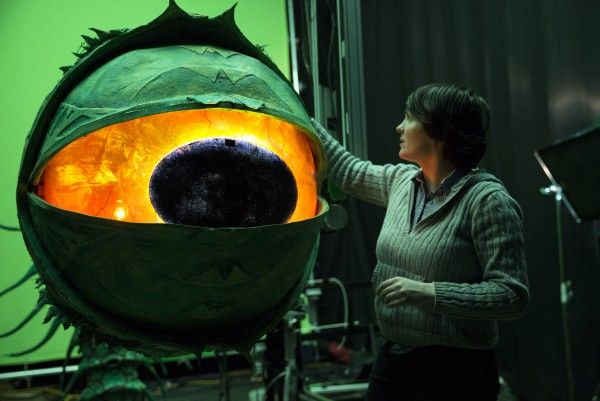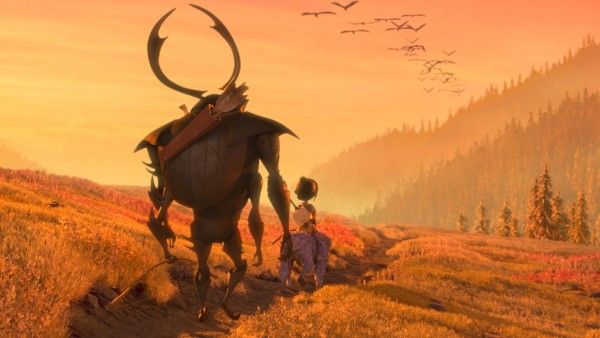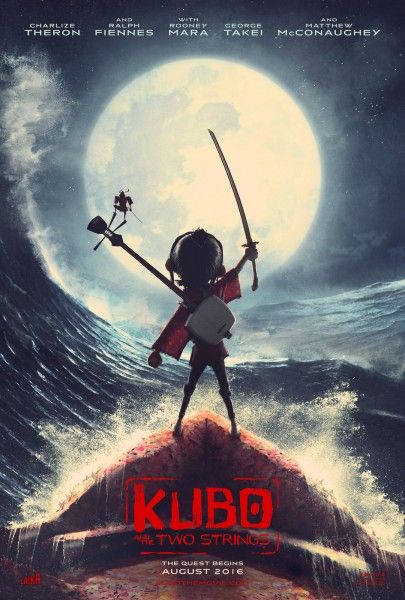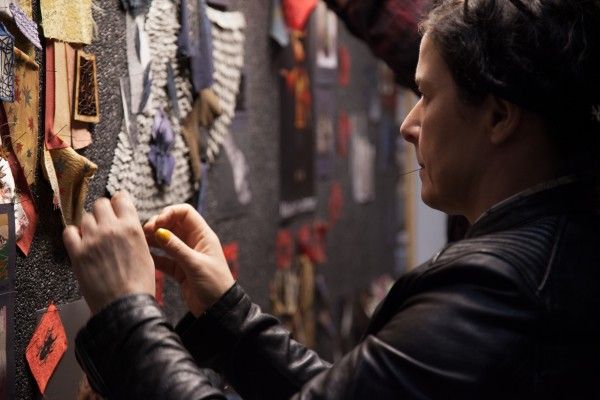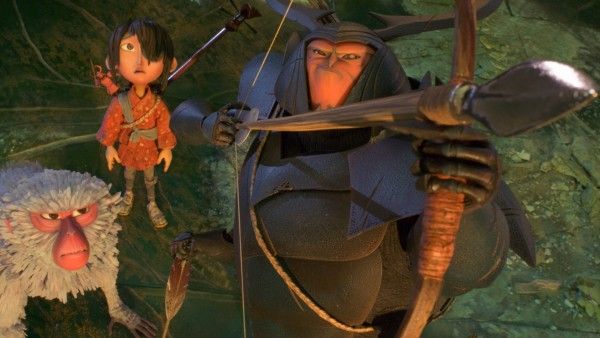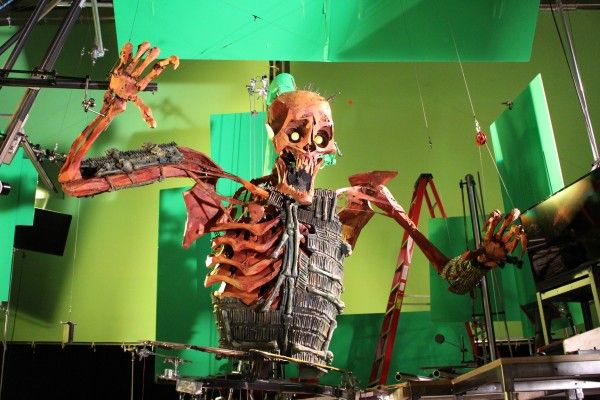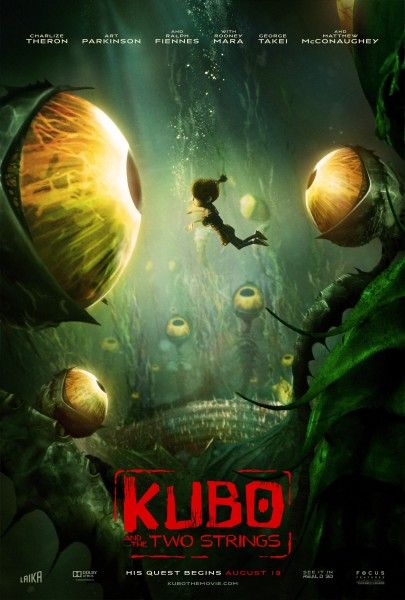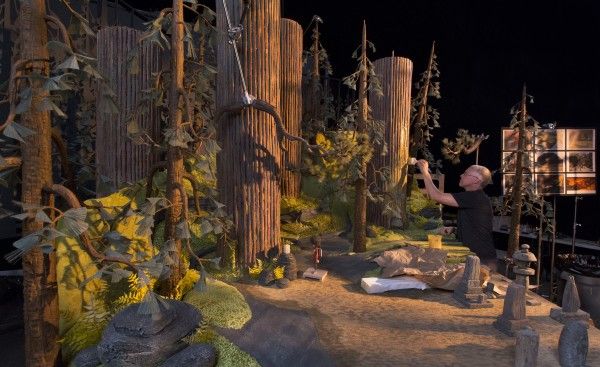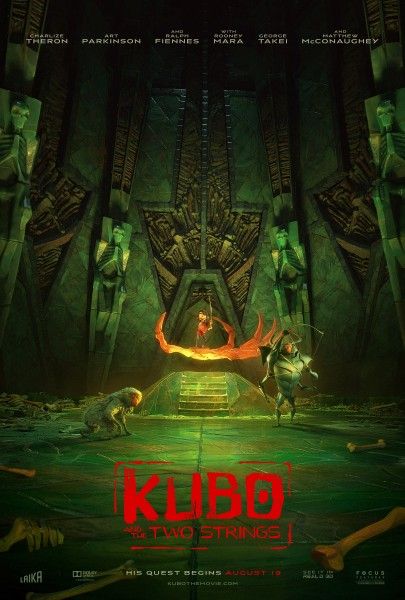For the last decade, Travis Knight has headed up the groundbreaking stop-motion animation studio LAIKA as CEO and head animator, shepherding the studio's trio of Oscar-nominated films Coraline, ParaNorman, and The Boxtrolls. With the Kubo and the Two Strings, the fantasy epic arriving in theaters August 19th, Knight steps into the director's chair for the first time, and he chose a doozy of a project for his directorial debut.
A sweeping adventure film inspired by the likes of Star Wars and Indiana Jones, Kubo and the Two Strings follows the title hero on his journey of self-discovery through a fantastical Japan, traversing staggering landscapes and incorporating extensive action set-pieces -- no easy feat for a film made one frame at a time. And he's doing it all with a voice cast any director would dream of with an all-star lineup including Charlize Theron, Art Parkinson, Ralph Fiennes, Rooney Mara, George Takei, and Matthew McConaughey.
I recently had the opportunity to join a small group of journalists to visit the LAIKA stages just outside Portland, Oregon. After we had the opportunity to tour the sets (you can take your own digital tour with almost 100 images here), Knight and producer Arianne Sutner sat down with us for a wide-ranging chat about LAIKA's history, continuing to push the envelop with technological and artistic achievements, taking on the tremendous challenge of a stop-motion fantasy epic, handling the transition from animator to director, their commitment to creating new worlds and aesthetics with every film, and a whole, whole lot more. This is a beast of an interview, but it's also incredibly insightful if you've ever wondered how the folks at LAIKA approach their one-of-a-kind movie magic, so I wanted to present it in full. Hope you enjoy.
I’m kind of curious, I was wondering for awhile why you made this the project you wanted to direct on and seeing as it’s a kid who has the power to make inanimate objects move through the room with his music. I think I see the connection.
KNIGHT: There’s definitely a connection. I think filmmakers are always trying to find that aspect of themselves you know in the stories. For me just thinking about our approach at Laika we always want to do something new. We always want to tell new and original stories, we don’t want to repeat ourselves, we don’t want to have a house style, that's why each film looks so distinct from each other. That’s why each world we create, we build these entire worlds for each one. It needs to have some flavor rooted in what the story’s about. So when we started thinking about Kubo five years ago, one of the things that got me excited was at the core of it, it was this big epic fantasy and it’s not the kind of story that you typically see being told in our medium, in stop-motion and there’s a reason for it, because it’s really hard . I think you guys got a sense when you were walking around, most stop-motion films feel like they’re shot on tabletop because effectively they are. It’s a bit of wood that’s been gussied up and that you know a camera on a stand and an animator moving a puppet around.
Well, inherent in this idea of this big epic fantasy was something that could be evocative of those great, epic stories that I loved growing up as a kid, you know things like Star Wars or a David Lane movie or Tolkien or Lone Wolf and Cub, things like that, that have this sweetness and scale and add some emotion resonance underneath it all but would be something that was really interesting and new being told in this medium and so we started moving on that way. The challenge that we put to our teams to create this Kurosawan myth in miniature. It was just a really exciting idea.
Now that’s kind of surface stuff. For me, the story it rings deeply personal for me. As you picked up on, Kubo is basically a proxy for me. He’s a kid, he’s a storyteller, he’s an animator, really when you think about it. His whole world revolves around his mother. He goes on this journey on exploration, this journey of discovery over the course of the film, this classic Joseph Campbell hero's journey and it really is about that point in our lives where we’re crossing the Rubicon from childhood to adulthood, and the things we gain and the things we leave behind along the way. And as someone who has gone through that experience as a kid and now someone as a father looking at my own children. You know I have a 15-year-old son, and a thirteen-year-old daughter, and a nearly three-year-old boy. And at various stages, you can see the things they’re experiencing, the struggles that they go through and knowing where it comes out on the other end. And so it’s an opportunity for us to tell this classic coming-of-age story in this incredible setting that’s a deeply personal thing for all of us. As I’ve said before for me it’s really a story about a boy and his mother well if I’m being honest, a mother and her boy.
ARIANNE SUTNER: It’s clearly about a mother and her boy.
KNIGHT: Monkey as you probably got a sense of throughout the day and the clips that you saw, she’s kind of a stand-in for Kubo’s mom. She essentially becomes a maternal figure for Kubo and Beetle becomes something of a proxy for his father. It’s kind of a makeshift family and as a director, you try to find pieces of yourself in all these characters and to see them without judgement which can be hard because some of them are awful people. You have to try to get into the psychology of it. What drives these characters? And that’s something that can be challenging but it’s really fun to dive into these characters, who are they, why are they doing this stuff, and to make them feel real and lived-in.
We heard that you filmed the beach sequence yourself. And knowing that on all the other films you worked on as an animator, you’ve had a very hands-on approach. I’m just curious about how it’s been transitioning into the role of director and maybe less having a hand in the film.
KNIGHT: Yeah, it’s been interesting and it’s definitely a transition. Early on, going back two years ago we were just getting started on shooting. I thought “oh yeah, I can do this. I can animate and I can direct and I can run the company all at the same time, no problem.” [laughs] You know I looked at models, Ben Affleck, Ben Affleck can act and direct so clearly I’m as good as Ben Affleck. I’m not as good as Ben Affleck it turns out. So no, it turns out directing is actually a full-time job but on everything we’ve done, I always want to keep getting my hands dirty, to have my hands in actually creating the stuff, not just calling the shots so it was important for me even as tricky as it was to schedule and as much havoc it wreaked on my life to try to find those moments where I could still get out on set and bring something to life a frame at a time. On a practical manner it would usually be in the beginning of the day before anyone got here, hammering out a few frames. We tried at one point to schedule “protected animation time” which was an hour in the middle of the day where I could go out and not be bothered and that went away very quickly. And then at the end of the day pretty much when most of the shoot is done and most of the people are going home, you’ll just go out on back of the set and try to crank out a few frames so it was slow-going which was weird for me because I’ve always been one of the faster animators on the floor but it’s kind of frustrating as an animator to not be able to have that devoted time to bring these things to life. Still it was really important to me to not lose that connection.
As an artist this whole process of directing a film on my own, it’s been the most creatively satisfying experience of my entire life and I’m more proud of this film that any creative thing I’ve ever done. As a director you become the nexus of all these different things and you’re interacting and being influenced by, and influencing other artists I think it’s just an incredibly invigorating thing to be a part of. I loved it. I thought it was a really amazing process and it was so great to be able to work with these artists in a different way. I mean, animators live a kind of lonely existence. We don’t really know how other animators really work because oftentimes you don’t really watch other animators animate. Yeah, you’re off in your own little world and there’s a frenzy of activity before an animator gets launched on a shot. You do the shot mostly in seclusion unless a light pops or a puppet breaks or whatever and then they’re done and can come back out in the world.
As a director, it’s the complete antithetical experience. You’re constantly surrounded and interacting with people all day long. One of the cool things too, was that director’s go on rounds so you have your check-ins with animators frequently throughout the process. So every afternoon, every morning, you would go in and check on a couple different animators for these set visits where you can kind of monitor their progress or if they have questions they can ask you, or you can course-correct things if they’re not going the right way. And that was eye-opening for me too because just to see how other animators work because I don’t know how other animators work, I only know how I work and so it was like “really, you do that. Well, that’s weird. You use that tool?”
So it was a really great experience, really eye-opening for me, really incredibly satisfying and kind of moving really, on some level. And now that we’re here at the end of the process I can see the hands and the spirit of all the different people who have touched the movie and you see it on the screen and all the pain that we’ve been going through over the course of these last five years it goes away when you see these things come to life in a way that you actually believe that they’re living, breathing things.
How was directing the voice cast?
KNIGHT: It was daunting never having done it before because we have some of the best actors in the entire world, people who’ve been nominated for and won basically every award in existence. I approached it kind of from an animator’s perspective, which is animator’s typically work from the inside out and by that I mean the animator, working with the director, will figure out what the emotional core is of a particular scene that they’re working on whether a character’s angry, where that’s rooted, where’s that coming from and then try to figure out physical gestures, movements, that indicate that emotion to clearly communicate the idea. Actors oftentimes work from the outside in. As a director you work with them from the outside, you do not tell them “oh you gotta be mad here,” that’s a no-no. You have to try to create a circumstance, a situation where they can actually feel that emotion and give you an authentic performance. And so it’s a completely different, in my mind, backwards way of working so I had to kind of retrain myself to figure out.
Because it’s not playacting, I think a lot of people have a misunderstanding of what acting is, it’s not pretending, actors are actually feeling those things in the moment and you can tell the difference between an authentic emotion. Sometimes it would take them, if an actor is getting worked up for a particular thing for a heavy emotional scene, it would take them a while to come down off of that because they’re actually feeling that. You could see the cheeks getting flushed and their ears are getting hot and all that kind of stuff and so you have to create those scenarios, those situations where you can get the actor to feel those things and it’s just a really interesting collaboration. And you know in your head you have who you think these characters think are and of course that changes or transforms in some way once you start working with these incredible world-class artists who have their own experiences, their own imagination that they’re bringing to the process and these characters evolve over the course of the making and that’s really exciting. And I think every step along the way whether it’s a designer or an animator or an actor, they’re bringing something more to it than maybe you could have imagined and it really does become an extraordinary artistic collaboration. So all told, it was a really rewarding experience working with these actors, pretty intimidating at first but once you worked through the process it becomes another cool aspect of filmmaking.
Can you recall any particular instances of what one of the voice cast brought to a character, any story or character changes that came out of those recordings?
KNIGHT: Yeah, I mean there are subtle things. Anything spring to mind?
SUTNER: I think Matthew had an idea with his character. It’s a challenge because you’re not intensely work for three weeks at a time, every single day so you’re going in and out of your character and return to it three months later. You stepped out and he was trying to find that throughline of who his character was at any given month and so he worked on you know, finding some of the humor, finding something that would not be Matthew, but would be this delusional optimist of the character so he had worked on bringing a lot to it. I mean I hate to say that. They all did, it was unbelievable, it was such a treat for us to work with these people but in terms of specifics I would say he tried to work on something to try to make. They’re treating these roles as if they were working in live-action. They’re not making caricatures necessarily they’re just coming at it as you would in a live-action film but just going through their voice.
KNIGHT: I think there’s the impression, in some circles, that voice acting is simple and it’s not. It’s very difficult, it’s very challenging and I think in a live-action film, an actor has a lot of different tools at their disposal. An actor, when you’re watching a film, they can break your heart with a glance or with a slight irregularity in breathing or a shift in posture. Their physicality, what they can do with their faces and their bodies, those can all communicate so much in a live-action film but they can’t do any of that in an animated film. The only tool they have at their disposal to express the entire range of emotion is their voice and a lot of actors can’t even do that. It’s a very challenging thing and then when you have this situation like we typically have in our films where you often don’t have the actors in the same room at the same time for a variety of different reasons you try to do that as much as you can, but for scheduling reasons, sometimes an actor will have to be there on their own and because of that the director will have to try to guide them in multiple different kinds of takes on different lines or a scene because you never know exactly what another actor is going to do and it's a way of getting coverage for a scene because we can’t shoot it so we get the actors to play the roles in a number of different ways just to make sure that those things work when we end up putting them together in the editing room and that feels weird for an actor that's a strange thing for them to play a scene in a way that feels wrong to them but these guys are all extraordinary pros and they did a lot of great stuff. It was interesting to see some of the process as I mentioned, try to get themselves feeling the actual emotion in the moment. There was a scene where we had the Beetle character he was really exerting himself and he had to have that kind of quality in his voice, in his breathing, and so Matthew he was in the booth and he just disappeared and I was like, “where’d he go?” and I stood up and I look over and he’s on the ground, cranking out an inhuman amount of pushups just to get his breathing and his voice in a certain way. And it’s one way that they can get those qualities out of their voice when they’re not actually in that moment and so it’s just really interesting to see those aspects of their process in the performance.
SUTNER: It’s interesting the kid, our young actor who was really eleven at the time, he talks about it in the most honest way about communicating everything through his voice. And I always love to hear him talk about it from his still kid’s perspectives, of “I just have to... through my words, through my voice” and he does an incredible job.
I was gonna ask if you recorded any of the performances and used it as a template for the facial animation?
KNIGHT: Yeah, I mean the trick with these things is that they take forever to make, the pace is glacial, you work on it for five years and yet when the audience experiences it in the moment you want it to feel like these things are spontaneously happening. It’s not all been sit down and figured out and labored over forever it needs to feel like it's happening spontaneously so one way you can do that and a way to try to get idiosyncrasies in the characters so they feel unique so it doesn't feel like they come from a general collection of faces that you’re using for basically every character, that this person speaks in a different way and their mouth and their face moves in a different way. One way you can assure that is you try to cast things appropriately with your designers and your animators but then when we are recording the voice actors we have a video camera trained on them and so we can see what they naturally are doing when they’re delivering these lines, what they’re doing with their body, how their face moves, and so invariably you learn something, and you learn something and you can then apply that to the character and so there are a number of different instances even though I don’t think the first thing that springs to mind when you think Charlize is necessarily an ill-tempered pursuit-ridden primate there are definitely aspects of Charlize and her face and her body language in the character because our animators look at what she does and they try to distill the essence of that into the way the character moves and speaks and so there's a lot of out actor’s physicality that finds its way into the characters and into the puppets.
SUTNER: Just the mouth shape too, you want to make sure it doesn’t look like a bad dub somewhere. You want to make sure that this character is brought to life and they are forming their O’s the way she would form her O’s as that character and it’s uncanny after a while. We do the designs, the designs are created often years before someone is cast and its uncanny after the final performance, after the movie is put together how much a character can look, a hairy monkey can look like the beautiful Charlize because there’s something in it that was really based off of her.
Obviously the marriage of stop motion animation and visual effects is something, you guys have been developing it for a while. It seems like it’s an important part of this production. But with the idea of stop-motion, when we were talking earlier about the wabi-sabi, the idea of finding beauty in hand-crafted material and the flaws, I’m curious how you kind of marry those two because obviously with CGI you could just make everything look 100% perfect.
KNIGHT: People often ask that when they figure out what we do, and then they go “why do you do it this way” and I think we do ask ourselves that sometimes on occasion given the challenges that we face. It really goes back to the beginning of Laika, when we started. For those of us who’ve been working in stop-motion for a good, long while including Arianne and I, I’ve been doing this for 20 years, when I got started stop-motion was already dying, it was already withering on a vine and quickly with the ascension of the computer it was only a matter of time before stop-motion was not even remotely a viable way to make movies or to make special effects or anything even though it had kind of hung around tooth and nail for nearly a hundred years. The computer can do anything you can do physically, better, in multiple iterations, you got way more flexibility and so when we started Laika, one of the core questions was what can we do with this medium, how can we make it do stuff that it hasn’t done before, how can we bring it into a new era and it really was about not fetishizing the craft aspect of it but trying to find a marriage of craft, and art, and technology, and science, and innovation, and blending all of those things together and so it was really about embracing the author of our demise by taking this infernal machine, the computer and making peace with it and finding ways that we can work and live together. And it was one of the best things that we’ve ever done because it allowed us to make films in a way that nobody on earth has ever made films and we have all these different people from so many different disciplines that come from, classically trained artists and we also have them working right alongside people who are inventing technologies, who are futurists, essentially.
So it was rough-going at first on Coraline, we started doing this on Coraline and oftentimes these people don’t quite know how to work together, because they have entirely different mentalities and entirely different ways of working but once we start living and working together we kind of start anticipating what the other needs and then it becomes a really exciting process, a real fertile ground for creativity and innovation when people start jockeying for “oh, this is a challenge, i can handle that.” And you’ll get all these different solutions to these problems from so many different areas of the company and it’s really exciting seeing that convergence of the physical and the digital. With Kubo, it’s just an extension of everything that we’ve done. We always try to do as much stuff in-camera as possible, just by virtue of you want to have a unified sensibility, you want it to all look like you’re shooting this thing at the same time. Anytime you composite another element into a shot, you run the risk of it feeling like it’s not knitted into the scene but we’re also not purists about it, whatever tool makes the most sense that’s what we use. The computer is a tool just like an X-acto blade is a tool. And it’s like what tool makes the most sense for this scene, for this shot, for this film, that’s what we end up using. And so to varying degrees stop-motion, practical effects, digital visual effects, and CG and 2D animation become a part of everything that we do, to varying degrees.
And so with Kubo, it really became, what is the best tool for this specific gig and one thing informs the other. We did a lot of stuff with water as a practical matter. Sometimes we do practical water that we shoot on-screen, in-camera, using like rippled paints of shower glass or cloth. So there’s a lot of different things that we can do because of the interactivity and the complexity of this film we knew that a lot of the water we were gonna have to capture digitally. So the first thing we do, I don’t know if Steve talked to you guys about it but we do physical tests and that then informs what we do digitally so in that way even though ultimately it comes from a different source, it’s informed by, if we had all the time in the world, how would we do it practically, that informs what we do digitally. It’s a really cool marriage of processes and it’s one of the things that gives these films their unique feel just because of the bag of tricks and the toolboxes so it's such an interesting array, they look and feel different.
SUTNER: You couldn’t have come up to solutions with that, you know striving for what is most beautiful. Because in CG it’s not always more beautiful in that way and the same thing practically and you can achieve something that is just right with computers. Saying earlier, how we’ll do, somebody talks about rapid prototyping and say “it makes our lives much easier” and I’m like “no, no, no, no, it just makes your animation better.”
KNIGHT: I think the idea of imperfect beauty, it’s a core element of the Japanese aesthetic and it’s something that we embrace here and have right from the beginning because as much as we strive for, when you make things by hand as much as you strive for perfection, you’re never gonna get it. There’s always gonna be imperfections, there’s always gonna be problems with it but I think that’s part of being human. You end up living with these things that try as you might and as perfect as you want to get them, and as elegantly crafted as they can be, there’s always something wrong with it. And that’s okay, there’s something beautiful about that.
SUTNER: That’s another theme that we run throughout the movie. Even in the very last scene of the movie, it’s kind of a part of that. What it means to be human, what it means to be perfect and there’s a version of our baddies who have a version of their world that is perfect and cold and supposedly unflawed and then the human aspect, what it means to be alive and have feelings and have warmth and have a couple of imperfections.
You talk about how you don’t necessarily want there to be a house style in building newer worlds for each film. Can you talk about how you guys find an entry point for that. It looks like this was obviously influenced by origami and your style here. How do you guys determine what is the right world for each movie?
KNIGHT: You know, sometimes it’s different for each show. Sometimes it’s a struggle to find exactly what the stuff of the show is and sometimes it happens pretty quickly. On our last film, we had Boxtrolls it was really intricate but it was suitable for what that world was, it was this Dickensian world with these off-kilter buildings, no straight lines, and there’s a bunch of stuff going on there from the design perspective that was rooted in the narrative which made sense. For this film that didn’t make sense, that’s not what this film was. For this film we used a lot of simple graphic shapes that were then detailed through the textures. If you look around, a lot of the designs are pretty simple, a lot of the buildings they’re very simple shapes and that was rooted in what the design influence for the film was, which was largely uyiko e which is these Japanese woodblock prints, some of the titans that I think some people would be familiar with are Hiroshige or Hokusai. There was a graphic artist in the 20th century named Kyoshi Saito who kind of took it in a different direction and he was probably the prime influence for the film and there was something that’s really beautiful and interesting about his work in that it's very simple, it’s very graphic, it’s bold swaths of color, asymmetry but a lot of the big vast swaths of color are then given texture by actually using the process, by pushing the woodgrain into the ink and so you see these incredible textures in his work driven by the process and it’s just really interesting and beautiful and the other thing that’s interesting about Saito was that he comes from a history of centuries of working in traditional Japanese woodblock printmaking. He did it all himself and he also was heavily influenced by European painters, Paul Gauguin, Henri Matisse, Jan Vermeer, and so it's that interesting distillation of East and West, old and new, and the real and the imagined that’s kind of synthesized inside this one artist.
And then on the other side you get something totally new which is absolutely something we do here on every film and so yeah, you’re right, you picked up on origami, there are these late Edo period Japanese doll-making things that we looked at for some of the design of the characters which is why they tend to be pretty simple and almost kind of porcelain-like in some of their features. Anything that’s outside of our own experience, we heavily research and then ultimately the film becomes a distillation of all of the things that we love and obsess over in our own lives and you kind of put it in a big gumbo and on the other end something new comes out and that’s an exciting thing for an artist to take these overlapping spheres of influence and put it through your own filter, your own life and then it’s a statement on the world which hopefully people get out when they see the film.
SUTNER: I love that question because that is something that is different for every show as Travis says and sometimes you don’t arrive at it as quickly as you want to. Sometimes you have a world of characters or characters and animals that all exist in their own world but you have to make sure that they exist in this other world that you’re creating and creating something that’s not exactly reality but you need to feel like you’re creating a designed water but that water, you can drown in that water, you can get wet in that water and it’s really like the stuff that the challenges of stop-motion, it’s really exciting and fun but also all the different technologies that you’re creating work, you’re creating classical work of a paint and you do using programs that are from a computer but you want to make everything feel as if it comes from your hand and that’s just something that sometimes it’s scary if you’re well into your second act and “why haven’t I seen the world yet?” Ideally as a producer my fantasy is that you create at the beginning a little corner of the world and you have your puppets in it and they match and you have your set and there it is. And sometimes it just develops and sometimes it happens really quickly too.
KNIGHT: Yeah some things are a struggle to get but every film we do it’s a stylized world. These are worlds that have a nodding acquaintance to the real world but they’re not the real world. THey’re informed by real places, real props, real sets, real locations, real people, but then they’re heavily stylized with whatever the design prism is in the show. That’s why you can see that cider woodblock texture in basically every surface of the film and it’s subtle but in the clothing, in the sets, even in the water, that texture is within it and it’s what makes it feel like a real place that has history, has tradition, it’s been lived-in, it doesn’t come out of a box but that typically is a process. We knew right away that we were heavily influenced by these Japanese woodblock prints as a design aesthetic but then distilling what does that mean exactly and how does that then inform all the other choices we make in terms of design for the film and in the end I really do think it’s a very unique world and I also know we will never do a world that looks like this again which is sad because I love this world but I’m also excited by challenges that come down the road and so this is our statement with this perspective and it’s exciting to share but it’s a little bit bittersweet to leave it behind.
How much time do you spend developing the script like before anybody gets started on the world. Are you sitting down with the writers and going over and what was that like for you this time as the director?
KNIGHT: It takes a good long while and because we’re not Disney, we’re an independent animation house, we’re not an international media conglomerate we have to be very, very careful about how we spend our dollars, our budgets are relatively lean. I think our budget for this film could probably cover what Disney’s craft services bill. It doesn’t look like it but part of it is being really smart about where we spend our resources. We really don’t design anything until we feel very good about the script. It’s kind of more of a live-action model, really. Oftentimes historically if you looked at animation, a ton of films like find it in the boards, and you can do great work that way, but it’s incredibly expensive. We just can’t do that, we want every dollar to be up on the screen, we don’t want any wasted effort and we spend much of our early time just figuring out who these characters are, who they are and what the story is and almost exclusively devoting our energies on the script and that’s only a couple of people that are working on that at any given time. You start burning through cash once you start adding people to the project. Little by little you start bringing more and more artists into the mix once you feel good about who these characters are and what this world is and how this script is shaping up then you start bringing in your designers who are figuring out what the characters look like and then you start bringing in illustrators who are examining what the world and locations look like and little by little you start bringing more and more people into it. But initially for the first couple of years it’s pretty much just exclusively working on the script.
So what was the first idea of Kubo when you guys were making Boxtrolls or whatever, ParaNorman. Were you like “oh, let’s make a movie about a Samurai kid,” what was the first idea, the first seedling for this film?
KNIGHT: Our character designer in the film, Shannon Tindle, it was his original idea and I sat down with him and the kernel of it was stop-motion samurai film. Awesome. The first time we had a conversation with Chris Butler going back eight years ago when we started talking about ParaNorman it was like ok, what do we think this thing is. Stop-motion zombie films for kids...fantastic. But it’s deceptively simple because that's great because then you have to have a story. You have to have a three-act structure, you actually have to have characters you care about and so you start with a very simple idea and then you start building it out. And those are the conversations that we had five years ago and then you start bringing people who can help bring that to life and we had a couple of extraordinary screenwriters, Marc Haimes and Chris Butler who wrote and directed ParaNorman who end up shaping the screenplay. And then you bring in your storyboard artists who are effectively writers in their own merit, they are kind of writing visually in a lot of ways and so they’re taking the foundations of it that run the page and trying to figure out how to then put it on the screen and a lot of invention comes in that process as well.
And so with each step of the process something new gets introduced and that’s really exciting and even though this thing makes half a decade to make, it never feels dulls to us, because there’s always some new thing, there’s always some new stage that you’re introducing, exploring a new facet of this move and it’s always evolving. So you bring your storyboard artists and then you do the blueprint of the film in your story reels and that takes whatever it is, about a year, a year and a half and then you bring in your animators and your designers and then they’re bringing in their own personalities, their own experiences to it and it just continues to evolve which is really exciting. You know, you have to be disciplined though about how you approach that stuff because as I said our budgets are relatively meager and we got to make sure that every ounce of energy goes up on the screen, that there’s no wasted effort but by keeping the teams relatively small and on Kubo, our animation team is 20, 25 people at its peak probably, which is a fraction of the animation team on a big, CG, feature. We do more with less, but also because we have fewer people, there’s more of themselves in the movie, it’s more of a like distilled thing of the personality and spirit of each artist that gets involved and I think that does give these films something of a purity to them, it’s not spread out among a thousand people who are only doing bits and bobs. It’s a relatively small teams who is pouring everything they have into these stories.
How early in the process did Dario’s score come in because music is such an important part of the story?
KNIGHT: I worked with Dario on the Boxtrolls and absolutely fell in love with him, he’s just such a dream to work with. He makes extraordinary, beautiful music. Music was a huge part of this movie, it speaks to the boy’s emotional journey, that’s how he communicates what he’s feeling and just like any artist what comes out in their work is essentially what’s roiling around inside them because sometimes there are things that we can’t necessarily articulate in the clearest way. Our art expresses that and gives voice to those things that we’re feeling. For Kubo, his magic, his music is driven by his emotions so if he’s feeling rage that's coming out in the music, if he's feeling joy, you feel that music, if he's sad that comes out as well. And so we had a lot of stuff that we needed to communicate very clearly with the music and the tricky thing on this film was that a lot of that stuff had to be seen playing, oft-times it was underscored that stuff being played that can support the narrative what the audience is supposed to be feeling but it's not necessarily synced to anything that's happening on screen.
Well with Kubo he’s actually playing a lot of that stuff within a score that supplements what he’s playing but it has to be rooted in the Shamisen, which is a very challenging instrument to get emotion out of, by the way. It’s a very simple folk instrument, similar to an American banjo which is, anyone who’s heard a banjo knows they're challenges in the thinness of the instrument but it can also be incredibly expressive if played right. So we started having conversations with Dario, I don’t know, about maybe a year and a half ago, talking about the project, basically giving him the rundown of what it was and then we needed a piece of music from him, essentially immediately so he wrote his first piece of music, it was over a year ago because we needed to syncopate it on screen when Kubo is playing these two pieces of music and it was the very first pieces of music that he wrote for the movie and also the most critical pieces of music that he wrote for the movie, which is a challenging thing for a composer when he’s like I’ve got to define what this movie is emotionally with these two songs and that’s gonna ripple through the entire movie and it’s a testament to what an incredible composer he is, that he nailed it and it’s so completely perfect for that moment and then it ripples throughout the film. He is just an amazing composer and we were completely in sync on this movie and you know for a character, Kubo who is effectively a version of Orpheus, someone who creates divine music, that’s a tall order for a composer, “Ok, I want you to have god-like musical powers in the name of this movie”
SUTNER: From a banjo.
KNIGHT: And he did it. It’s amazing. One of the most moving experiences for me in this entire process was going to London where we did the score and sitting in the recording studio that George Martin built and listening to this incredible score that these beautiful musicians are making for our movie that’s evoking the emotion of our story that we’ve been working on for years and it was very very movie hearing those first strains of that score and I remember, Dario is conducting and he looks back at the recording booth and we’re like … [Laughter]. But you can listen to the score and you can absolutely feel what our character is going through without seeing anything on screen which is a real testament to his abilities and the abilities of the musicians to pull that stuff together. It’s really amazing.
It would seem incomplete even in the creative process if you don’t have it in tuned as an animator?
KNIGHT: For stuff that you on screen you absolutely have to have at the very least a sketch of it so the animator knows what the fingerings are, roughly the tempo and the rhythm of it are because otherwise it just wont line up but it's also true that as filmmakers we learn something. Anytime a new artist comes on board, particularly, world-class artists like Dario as they start giving their interpretation of the material, you might see the scene in a different way, it’ll have a different color than maybe you had expected and sometimes that changes the course of what a scene or a sequence might be. You see different possibilities and I think that’s true of any great artistic collaboration, that you’re always feeding off each other, you’re always influencing each other and informing each other and that was certainly true with our collaboration with Dario. It was just an amazing part of the process, it was really great and that was another aspect of its a new part of the process doing this the score and composing and it was just something that was completely exciting and another way to tell the story.
Laika has made one short film, Moon Girl. I know you guys have a much smaller team than places like Pixar or Disney but are there any thoughts any plans?
KNIGHT: Nope. I think there’s a misunderstanding of what it takes to make a short. It’s incredibly hard to make, it’s a feature film, it’s just smaller.
SUTNER: Especially if you’re creating a whole new style for each film.
KNIGHT: Yeah. I’m certainly excited by potentially telling stories in shorter form but we only have so much bandwidth and all of our energy are going into making these original stories on a feature length level and the shorts are interesting and I think Pixar has used them in an interesting way in that they typically try to use them as a testing ground for talent and technology and it’s worked really well for them but we effectively cannot afford to do that.
SUTNER: Those budgets are considerable so I always think when we’re competing in awards season for the person who’s doing their
KNIGHT: It’s always David and Goliath.
I think they take a loss on those shorts.
KNIGHT: You always do. You can’t monetize. There’s virtually no way to monetize a short so there’s all of that. As a business model it doesn’t work. As a creative thing it’s exciting but we pour every ounce of energy we have into making our movies and I would never want to split that off because the same people you want creating beautiful shorts you want creating a beautiful movie.
SUTNER: And we want to have a legacy of these enjoyed movies and shorts are fantastic forms of entertainment but if we’re putting all this, five years to pull this off it kind of pulls you in a few different directions. There’s a lot of reasons in a perfect world where that would be great like to do a...
KNIGHT: Oh boy, here it comes.
SUTNER: Just kidding. I was like we should do something episodic on all this amazing television right now but you know it’s so much time and energy and passion and limited amounts of space and resources so we put it into these beautiful movies.
KNIGHT: Yeah, we have to focus and our focus is on making films.
I was here on ParaNorman and Boxtrolls but scale seems to be such an incredible innovation, just looking at the Skeleton and the Garden of Eyes these are bigger things that we see from...Looking at this project and obviously technology kind of continues from project to project if that’s something you guys are even looking to explore further and kind of the bigger objects.
KNIGHT: It’s hard to imagine a bigger puppet than the Skeleton. I love that Skeleton because with every film that we do there’s a new challenge that we have to figure out and that where a lot of the innovation, where a lot of the creative and technical thinking come from and it's one of the things that I love about artistry and technology. It’s not a matter of reflecting what is, it’s a matter of imagining what could be. And that’s every form of innovation through the course of humanity, that’s what it is, what might be, what might we do, with every innovation that we do an a film we can then apply those learnings to the next film. And so the giant skeleton really was rooted in terms of how we pulled it together, on our last movie, on The Boxtrolls we made this weapon of mass destruction that the villain has, this big mecha drill and we didn’t know how we were gonna do it, we were gonna do it as a scaled -down model and as we started working through the basic process though, we realized it’s just really a big puppet so let’s just kind of scale up the rigging and everything else and it’s just really a big puppet, let’s move it around on a 100% scale.
SUTNER: And then make Edie film it.
KNIGHT: But then after we did that we’re like what’s a giant skeleton, it’s just another big-ass puppet, very big. It’s kind of ridiculous, really. It’s essentially it’s a moving set and it has to perform but I love all the technology and everything that went into making it because it’s really high-tech. We developed these new systems, these new gears and everything to bring it to life and yet on the other hand we have an arm that's held up by a cable and a bucket with sandbags so it’s just lo-fi and hi-tech merging together. The great thing about that is that once we conquer a challenge like that we know we can do it. It just makes me evermore confident in our teams that we can tackle pretty much any challenge even though in front of us we don’t necessarily know how we’re gonna do it. Some genius always figures out a way to get through it and it’s inspiring.
SUTNER: It would have been fine if we had done that in CG. We didn’t want to do it. It energized us and scared us and challenged us to be able to make it like that. And we’re so damn proud of it and we love to show it off.
KNIGHT: There is an inherent restlessness here, that we always want to challenge ourselves, that we don’t want to settle. We are always looking for that new, great artistic challenge but I wouldn’t want to do some big thing just for the sake of doing it. It really has to be rooted in the story that we’re telling so as I look at the next couple of films, knowing what they are. I’m not going to tell you what they are, they’re different kinds of challenges, they are not those kinds of challenges but it’s something else that we haven’t tried before, which is exciting to me so you can tick that off the box of things that we’ve done and it's great knowing that if we need to do it again, we know how to do it but then we can apply all that energy into something new which is really incredibly exciting to me.
Will you talk about merging old school and modern technology and we saw examples of that ... a bowling ball. Is that an open forum for everyone involved, “hey we should do this,” is that always how it works?
KNIGHT: Yeah, we often have these breakdown meetings early in the process, where we’re going through the sequences, we’re going through the storyboards and we’re going “ok, how are we gonna do this,” and we get all the key leaders of the departments in a room together, this exact room actually and we start talking about, “ok, what do you guys think” and invariably there’s someone…what we do is a car park, “we don’t know how we’re gonna do it, we’ll figure it out later,” but then someone will pipe in “hey, what if we did this” or “hey, i got an idea about how we might do that,” like the head of the rigging department might come up with a solution for something and someone in visual effects might or someone who’s working in our pub department might come up with a solution that has nothing to do with their particular area of expertise. It’s one of the things I love about the community that we have here, is that everyone wants to create something new and exciting and so it’s just an invigorating to be a part of but it really can come from anywhere, some of the solution that happen on Kubo came from some unexpected places. We didn’t know how we were gonna do half of those things and oftentimes the solution would come from an unexpected place, some artist who actually had done something in their own free time and like “hey, that might be applicable to this” and we start talking about it and all of a sudden that makes its way into the movie.
Are there ever cases where things might not work out for a project but the discovery can then be used on a future project?
KNIGHT: No. I mean there are definitely things that we do that don’t work as well as we like and you always learn from that too, you learn from failure as much as you do from success, maybe more, but as I said we have to put everything into the movie so it’s not like “oh well, that was an expensive thing that didn’t work out,” no, it’s going into the movie even if it’s not great and we’ll just figure out a way to make it great. And I’m reminded of when we did ParaNorman, we were introducing a new kind of printing technology that we hadn’t done before and we had done rapid prototyping on Coraline and we were doing something entirely new that would give us greater verisimilitude, greater opportunities for doing really cool textures and character paint on the faces, really making it come alive but the technology wasn’t very good and we had some tests where we tried it out and it looked awful, it looked so bad, and so we were at this inflection point where we had to choose do we go forward with this untested technology and figure it out and commit to it knowing that it could be a disaster or do we stick with what is tried and true and will get us there even if it doesn't quite live up to our hopes of everything that it might be and of course we go down the path where “all right, let’s give it a shot, roll the dice.” And again it’s a testament to the teams that they do it, that they figure it out. It’s why it’s so totally inspiring to be a part of this place is that you have world class artists and technicians who dream big and bring these things to life in a beautiful way so it’s a cool thing to be a part of.
How do you handle cinematography. It seems like a lot of it is decided in boards and animations and animatics. Each animator kind of has to be their own cinematographer a little bit.
KNIGHT: That’s not exactly true. If you do it in analog to live action, an animator is essentially your actor, they are acting through the puppet but that’s the main thing that the animators focuses on, the performance of the puppet, making them come alive. We have lighting and camera teams who work on the lighting on the sets, how the camera moves, the placement of the camera, the movement of the camera and so our director of photography, Frank Passingham was the guy that I had worked with on Coraline and he’s just an incredible artist, he absolutely understands the marriage of darkness and light, and the ballet of puppet performance, the camera. So for this film, again this film was an extension of some of the things we learned on the last couple of films. On Boxtrolls there was a critical thing for me that the film did not feel like it was shot on a tabletop, and on a tripod, that the camera had some life, that it took cinematography in stop-motion to another level, that it made it feel more like a live-action film and so we learned a lot in that process and were then able to apply that to Kubo. It’s really, really challenging.
There are some really big action sequences in stop-motion work that are not easy and there’s a reason why most people don’t do them. When you do an action sequence in a live action film you get a lot of coverage and you get down to the edit bay and you distill it down to its essence but there's a lot of stuff that goes down into making them. We can’t have any wasted effort in stop-motion so every frame we shoot is precious and basically has to go into the film so there’s a lot of thinking, a lot of math that goes into how these cameras are moving, we map out the entire sequence: how does the camera move, what is the interplay between puppet and camera, what’s going on with the light, where do we want the audience to be looking, how can we make it feel like this is happening in the moment.
All these conversations that go on for months on end and then you watch it and hopefully you don’t feel any of that, hopefully it all feels like it’s spontaneously happening in the moment and it really is again, a testament to the team of our light and camera teams and our animators that that marriage works so well. Because it’s also very challenging for an animator to animate to a moving camera. It’s relatively easy when the camera is static because the only thing you have to keep track of is the motion of the puppet but when the camera is swimming around on every frame you’ve got to keep track of what the puppet is doing independent of what is happening with the camera and sometimes it can start messing with your brain and so it’s incredibly powerful how talented these guys are, that they keep all that stuff in their head and make the thing feel like it’s happening in real time.
SUTNER: It’s real cinematography. It is live-action, it’s just more of a special effects movie, it’s incredibly slow and just incredibly controlled. We use all real light, beautiful fabrics reflecting, tons of gobos. That ‘s a little joke for Travis there.
KNIGHT: Lot’s of gobos.
SUTNER: Yeah a lot of gobos in this movie. And it’s just as good cinematography as you’re gonna find I think out there. I think that’s part of the joys of stop-motion and why we keep doing it. I think you cannot...CG is so, so beautiful to its own merit but it's pretty hard to capture what we are capturing right now. Even if we’re more traditional like a lot of live-action movies when we go in for color correction with the Director and the DP who are there working with the colorist and not your production designer where you’re working with more CG in a sense. Also, what else can I bore you with? Our camera and lighting teams really understand the fundamentals of stop-motion. Some of them have animated a little bit before. So they’re all like these uniquely talented people that we are so lucky to have come here and they are a wonderful team, they take turns, sometimes DPing and they’re a jack of all trades. They’re incredible, emotion-control engineers. Previz, they’re kind of a talented group of fellas.
KNIGHT: It’s a small team, they’re really, really talented, hey have experience in stop-motion and live-action. I think one of the reasons our films have their own interesting aesthetic is because a lot of them, we’re working in animation, but a lot of these guys have backgrounds working in live-action and so it helps to give it that feel. They’re lit like a live-action film would be, because that’s how, that’s what we’re doing, it’s a real stage. And because we’re able to control the camera movement on motion control, it’s repeatable. You can shoot things in elements so for animator access, sometimes there’s a big thing in the way of the animator and the animator can’t get in there but we can carve bits of the set away and the animator will get in there and move the puppet and we’ll shoot that as a pass and we patch it all together and we do another pass where we put it together on the computer and it means that the animator can just focus on getting a great performance rather than their lower back pain but we can still have something that’s beautiful and is all knitted together. As Arianne said the DP on our last film John Ashlee he’s a lighting and camera man on this film working under a DP who was a lighting and camera man on a different film that we did. So they’re all exceptional artists. Any single one of them can be a director of photography and probably in the course of time will on one of our films and then in like measure we have a guy who is of that caliber who will then just go back to being part of the crew working on the next show. It’s a really amazing group of people.
And how has the experience been working on multiple projects at once?
KNIGHT: We always do it to a degree. While we were shooting ParaNorman we were developing this. And so it's like you’re brain is carved up in a bunch of little places, you're focusing on a lot of different things at any given time. We’re developing films now that won’t come out for 10 years so there's a lot of things that you’re juggling at any given time but this was the first time that we actually had two projects that were overlapping. We were shooting, we were finishing up Kubo and we were starting the next show that comes beyond that and as you can see with the expansion that we have on the other side, west side of the building, that’s what that is about, creating enough space. What we do is run out of space, you need space for this stuff and it’s just making the box bigger so that we can put these sets in so that we can overlap the productions in a more meaningful way.
SUTNER: And he wants much bigger sets.
KNIGHT: It’s challenging because it’s not like the team is appreciatively bigger. It’s just that as the animators and designers and storyboarders kind of go from one project to the next, it’s great that you have continuity on the artists and I think it’s why these films have their own unique personalities, the DNA comes from the same place. We have to make our teams bigger and like I said before we do a lot with a lot less. Our visual effects team on Coraline is essentially the same size as our visual effects team on Kubo but you would never know that based on how complex the visual effects are. But everyone is just great, they’re a star. It’s exciting to me the idea of bringing these films closer together because there are so many different stories that we want to tell and time is not your friend. There are only so many films that you can make over the course of your life, particularly if you make films the way we make them and there’s a lot of stuff that we feel like we’re just scratching the service, a lot of different stories I want to tell in a lot of different genres and so the only way we can do that is by more meaningful overlapping, which we’re gonna start doing now.

